How to Make Sourdough Starter with Less Flour
I’ll teach you how to make Sourdough Starter from scratch without any commercial yeast. You need just 3 ingredients and 7-10 days to begin making real sourdough bread at home.
I’ve updated the process to use less than half the total amount of flour to create a lively and ready to use starter.
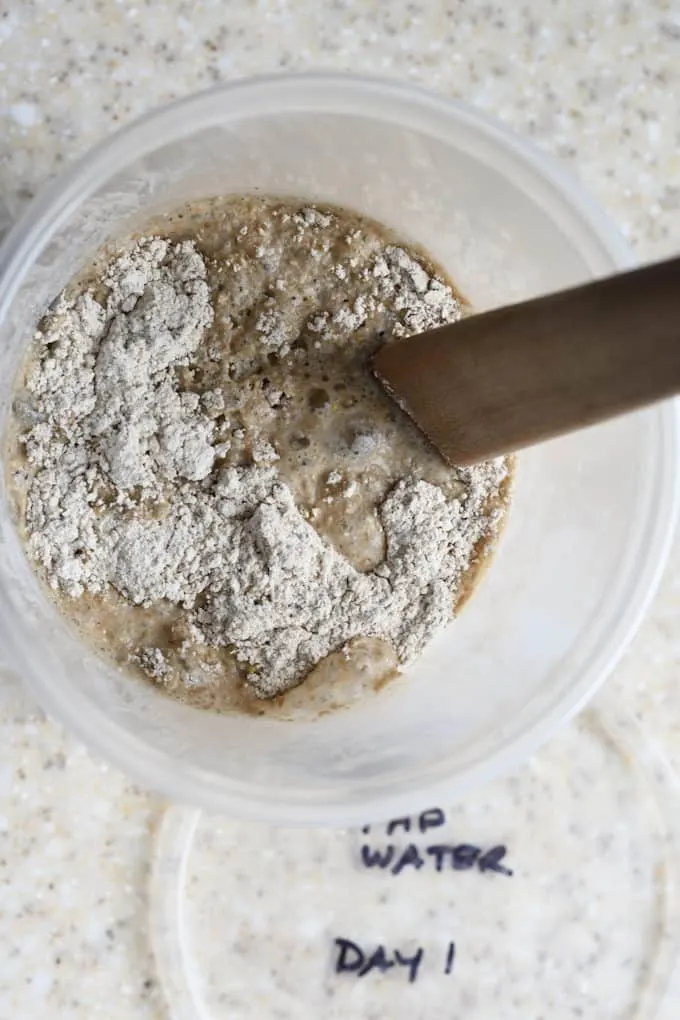
If you’re new to the world of sourdough baking, I’m so excited to get you “started” (pun intended!). Before you know it, I think you’ll be as obsessed as I am by the incredible living thing that is sourdough.
Yes, a sourdough starter is a living batter. It is built over several days to cultivate wild yeast from the environment and from the flour itself.
There are many ways to create and maintain sourdough starter. You may have read all sorts of warnings that you must use bottled water, that you should take it on vacation with you and treat it like a child. Relax, it’s really not that complicated.
I’m going to explain to you, step by step, how I created my starter. Along the way I’ll bust some myths about sourdough starters and, hopefully, show you that’s it’s really a very simple and forgiving process.
Once you have a starter, as long as you feed it periodically it can, theoretically, live forever.
How to make a sourdough starter using less flour
Although flour is usually inexpensive and easy to come by. It’s always good to create less waste.
So I revamped my process for creating a sourdough starter. With this new recipe the total amount of flour used is reduced from 30 oz (about 6 cups) down to less than 2 1/2 cups (12 oz).
The key is to keep the starter very small for the first 6 days of the process.
On day 7 we begin to bulk up the starter. By day 8, which is usually when the starter is active enough for baking, you’ll have a full 12 oz of starter. That’s enough to bake a loaf of bread and use what remains to continue feeding the starter.
All of my notes and photos for making a starter are still accurate with this smaller starter method.
Tips for making a successful Sourdough Starter:
- You don’t have to use bottled water to make sourdough starter. I mixed two starters side by side, one with bottled water and one with tap water. You can see in the process photos that they behaved exactly the same. As long as your tap water is good to drink and is not excessively chlorinated, there is no need to use bottled water. I baked with both starters with good results.
- I like to begin the starter with half all purpose and half whole grain rye flour. The wild yeast likes the extra nutrients in the whole grain flour.
- The whole grain flour gives the starter a bit of a boost and nice flavor, but if you can just all purpose flour is that’s what you have on hand.
- This is a 100% hydration starter. That simply means that it is made and replenished with equal weights of flour and water.
- For best results, weigh your ingredients. The weight of the flour can vary based on how you fill a measuring cup. Weight measurements are most consistent and accurate, especially when working with small amounts in the beginning of the process.
- The warmer the room, the faster your starter will activate. Since I was working in the winter months, I placed my starter near the furnace in our basement.
- About day 4 or 5, the starter may start to smell cheesy (like sour milk) and may not rise as much. Don’t give up! The smell will gradually become more yeasty/fermenty and less cheesy. It will sort itself out as random bacteria die out and the good yeasts take over.
- Use a plastic or glass container so you can see the progress of your starter. I like to use plastic, quart-size deli containers. They’re cheap and reusable. Get extra containers so you can transfer the starter to a clean container each time you feed it. They’re also handy for giving away starter to your baking friends.
- Once your starter is ready to go, you can bake with it right away.
Scroll through the step by step process photos to see how the starter looks each day:
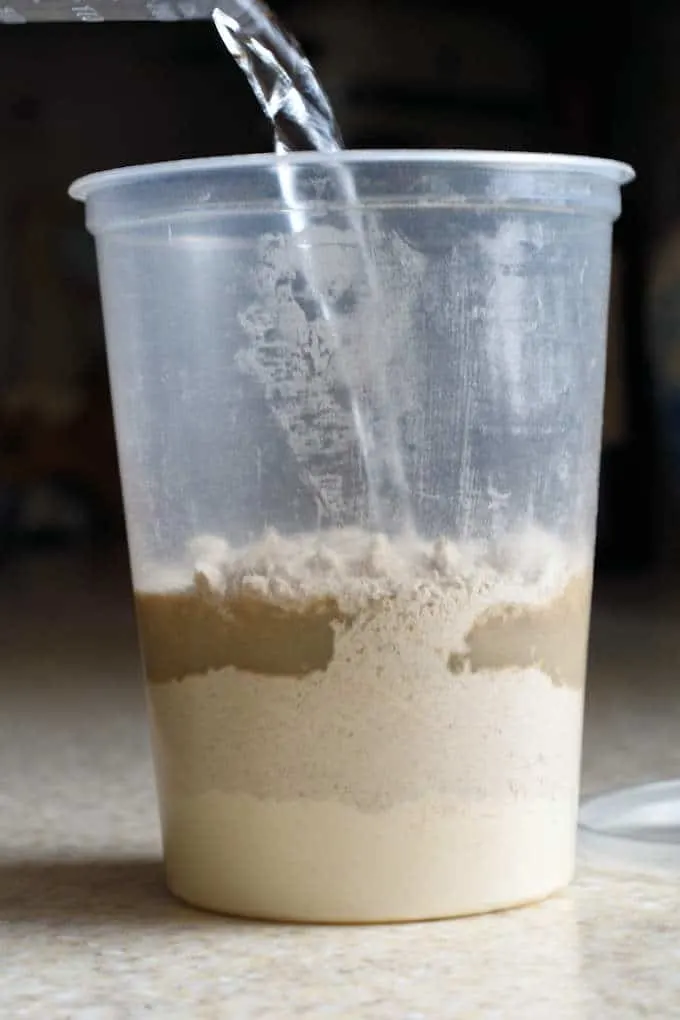
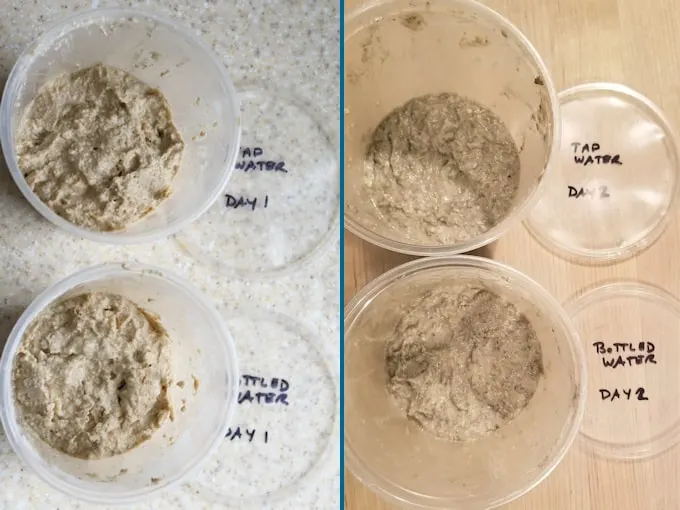
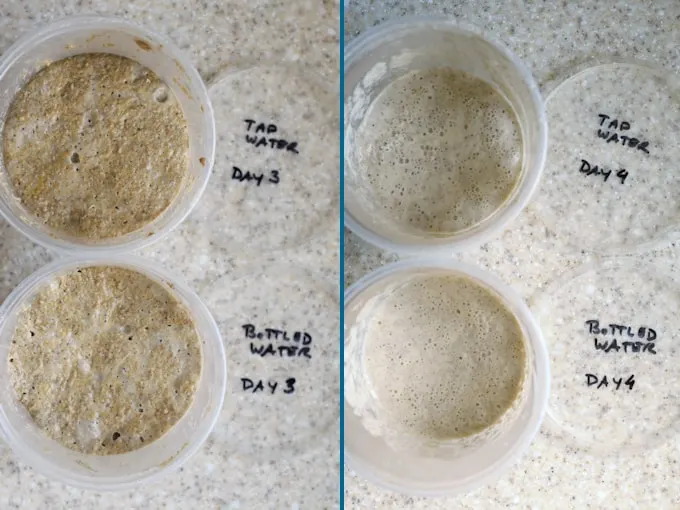
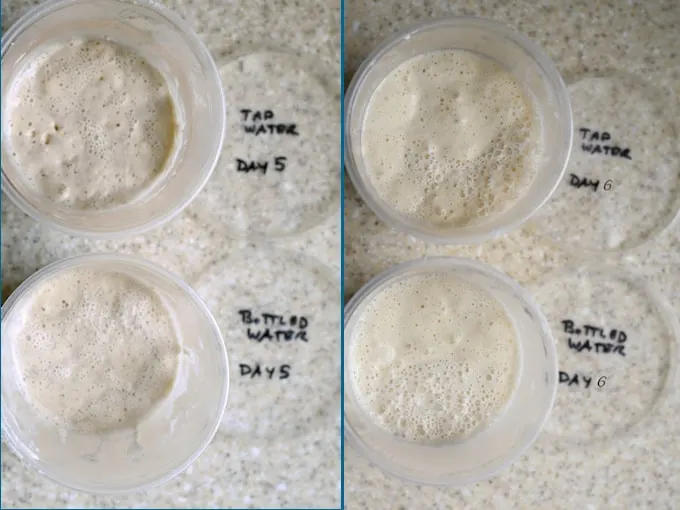
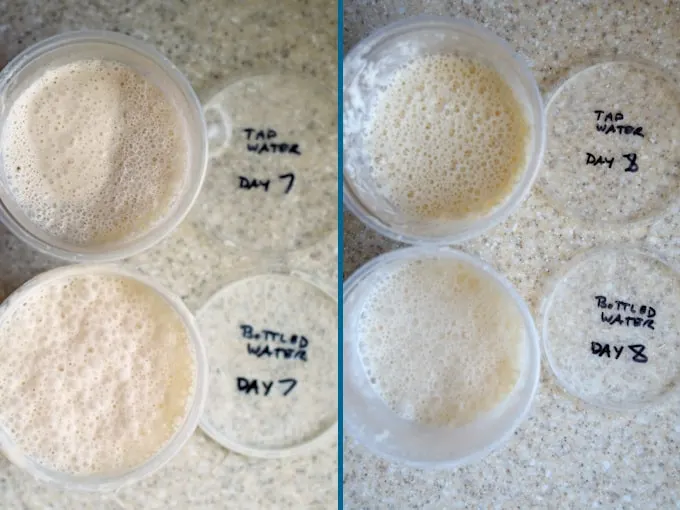
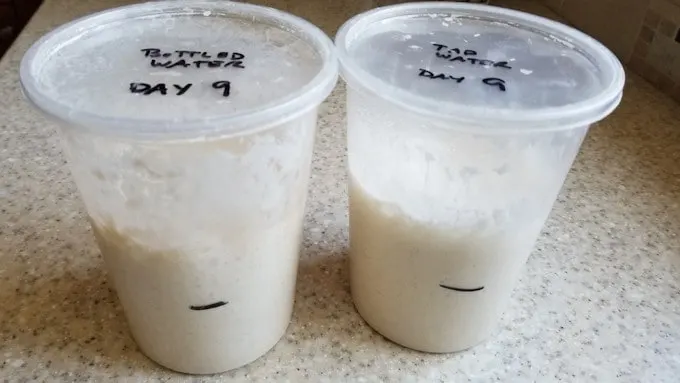
Daily Notes on My Sourdough Starter Progress:
- Day 1. Mixed at 11am.
- Day 2. No activity.
- Day 3. Doubled in volume, smells “grainy”, like wet rye. Not pungent. Fed at 11 am.
- Day 4. Rose to fill the container overnight, then collapsed. Smelled cheesy. Fed at 1 pm
- Day 5. Didn’t rise much, cheesy but less pungent, fed at 12 noon
- Day 6. Rose almost double. Smelled less cheesy, more sharp. Fed at 12 noon.
- Day 7. Rose to double and almost overflowed the container. No cheesy smell, just fermenty, yeasty smell.
- Day 8. Both rose to fill the container. No cheesy smell, smelled pleasantly fermented and yeasty. Ready to use.
- Day 9. Left at cooler room temp overnight. Rose to double in less than 6 hours and didn’t collapse by 24 hours. Nice yeasty, beery smell. First day baking.
Congratulations! You’ve done it! You’ve created a living batter filled with wild yeast. Now let’s see how to feed & maintain your sourdough starter. If you want to continue saving flour you can follow these instructions for How To Keep a Small Starter.
Now that you’ve got your starter ready, check out the entire list of My Best Sourdough Recipes. Have fun!
I know you hate to throw away that sourdough discard. Check out these recipes that use sourdough discard.
Finally, did you know you can dry your sourdough starter? It’s true. Dried starter can be stored at room temperature indefinitely without feeding.
If you love this recipe as much as I do, I’d really appreciate a 5-star review.
Sourdough Starter Recipe
Ingredients
- 1 oz unbleached all purpose flour
- 1 oz whole grain rye or whole wheat flour (see note)
- 2 oz water (room temperature)
- 10 oz unbleached all purpose flour (for feeding)
Instructions
- On Day 1, combine the all purpose flour, whole grain flour and water in a pint size glass or plastic container. Mix until it forms a thick batter. Loosely cover with plastic wrap or a lid.
- Set aside at warm room temperature (about 75°75 °F-80°F80 °F is ideal) until the mixture starts to bubble. The warmer the room temperature, the faster the starter will become active. This usually takes 48 hours, so there is no feeding on day 2.
- On day 3 weigh out 1 oz (28g) of the starter and discard the rest. Combine the reserved starter with 1 oz (28g) all purpose flour and 1 oz (28g) room temp water. Stir to form a thick batter, cover and set aside at warm room temperature for 24 hours. After 3 or 4 days the starter might smell cheesy. It’s fine. Keep feeding.
- On days 4, 5 and 6 feed with the same procedure. Weigh out 1 oz (28g) of the starter and discard the rest. Combine the reserved starter with 1 oz (28g) all purpose flour and 1 oz (28g) room temp water. Stir to form a thick batter, cover and set aside at warm room temperature for 24 hours.
- On day 7 weigh out 2 oz (56g) of the starter and discard the rest. Combine the reserved starter with 2 oz (56g) all purpose flour and 2 oz (56g) room temp water. Stir to form a thick batter, cover and set aside at warm room temperature for 24 hours.
- On day 8 you’ll need to transfer the starter to a quart size container. Weigh out 4 oz (112g) of the starter and discard the rest. Combine the reserved starter with 4 oz (112g) all purpose flour and 4 oz (112g) room temp water. Stir to form a thick batter, cover and set aside at warm room temperature for 6-24 hours.
- The starter is often ready at this point. The starter is ready to use for baking when it doubles in volume within 8 hours of feeding and has a pleasant, slightly fermented yeasty aroma. If that hasn’t happened by day 8 continue feeding until the starter is ready.
As an Amazon Associate and member of other affiliate programs, I earn from qualifying purchases.

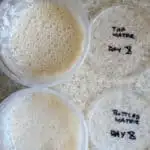
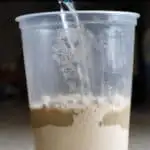
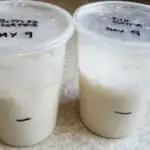



Sorry, I posted this in the feeding page on accident. I’m on day 6 of starting the starter and I’ve been following the directions. I went to feed it today and there’s a fuzzy white layer on top. When I put it in a jar is the jar supposed to be sealed or should it just be covered? I’ve had mine in a canning jar with plastic wrap over the opening and then the lid and seal on top of that.
If there is fuzzy stuff on it throw it away. The jar should be lightly covered. Just plastic wrap or the lid, ajar, is good. I think the mold might have taken hold because there was no breathing space.
Thank you. I’m trying it with plastic wrap. So far so good. It was doubled and bubbly about 36 hours in so I fed it woke up to it being doubled and bubbly about 12 hours later. Should I keep feeding it every 12 hours if it keeps doubling in that time frame?
Thanks for your very informative site!
This is my second attempt at home baking and planning on making sourdough pizza. I began a whole wheat starter 8 days ago with a recipe that uses unsweetened pineapple juice for the first two feedings and now it appears ready to go!
I’m a little confused about the “discard” recipes. Can the discarded starter be used for any sourdough recipe or are those recipes different?
The “discard” should just be used in recipes that say to use discard. The discard won’t be as active as a recently fed starter so the discard recipes usually don’t rely on the discard for leavening.
Can whole wheat flour be substituted for all purpose
Yes.
Hi Eileen
Love your site. I’m going to be using mainly spelt flour in my bread baking as modern wheat products tend to disagree with me. Can I still make your starter and then use spelt for the bulk of the baking or should I use spelt all the way through. And do you have any tips on using spelt as opposed to AP or normal bread flour.
Many thanks
Jill
I don’t have personal experience with Spelt. I believe you can make the starter with it. How the dough will behave I can’t be sure. Anyone else have experience with spelt?
Do you only use the rye flour for the initial mix? You only use all purpose when you feed it?
Hi,
I’m am building the rye sourdough starter. I had a friend tell me the fed their starter with potato water. Have you heard of that and is there any advantage to doing it?
Thank you
Jim
I imagine the yeast would like the sugars in potato water.
Hi again, you can discard my previous question, I read through your article a little slower the second time around,and you explained it quite well.
Thank you for this article. A quick question. I’ve been storing a starter given to me in the fridge for a month now. Every week, I have been adding 50g each of flour and water, without discarding any of the mother-dough. Should I be discarding weekly and basically mix a new batch comprising of 1/3 mother-dough, 1/3 flour and 1/3 water? Thank you.
The main reason for discarding is to keep the starter amount at a reasonable level. Also, if you always add 50g each flour and water the starter will be thrown off balance since presumably you have more than 50g of starter at this point. I suggest feeding the starter with equal weights of starter, water and flour.
Oh.. I don’t know what you mean by ‘discard’ the rest.. Do you mean throw it away please? Sorry, this is all very new to me. Anne
Yes, as you’re building the starter you should discard some of the starter each time you feed it. Otherwise it will grow exponentially. Once you have an established starter, each time you feed you can use that discard in any number of recipes. When using the discard in a recipe it’s there for flavor and texture, but will not contribute significantly to rising.
I have been using your sourdough recipes and am very pleased. I’m stumped with my new adventure and need some advice. I have a friend who loves my bread but must stick to a strict low carb diet for medical reasons. I’m trying to determine if I can create a starter using almond, coconut or another type of low carb flour, APF is off limits for her. Have you ever tried this or have any thoughts?
Sorry, gluten or carb free is not my specialty. You might have luck googling on gluten free websites.
Hi,
I have followed your recipe for starter and and the artisan bread recipe – I am wanting to buy a proofing basket – what size for this amount of ingredients please – I have to buy online as not available where I live and am so confused size wise – I do like the oval shape.
Thanks
Candy
This is the proofing basket I use. https://www.amazon.com/inch-Premium-Banneton-Basket-Liner/dp/B06XJ698WV?crid=2I589Y2XE05YU&dchild=1&keywords=bread+proofing+basket&qid=1620655334&sprefix=bread+proo%2Caps%2C165&sr=8-17&linkCode=ll1&tag=bakisens-20&linkId=c4e33fed868b31a76bb705ff4512abc3&language=en_US&ref_=as_li_ss_tl (As an Amazon Associate and member of other affiliate programs, I earn from qualifying purchases.)
@Eileen Gray,
Thank you
Hi, My starter was doing fine then, bubbly doubling in size and kind of stinky! Then on day 5, nothing. No smell no bubbling nothing. Is it dead and I should start over? I was so close.
By “kind of stinky” do you mean a cheesy smell or a yeasty smell? I find that about day 3-4 I get a couple of days with a cheesy smell that eventually gives way to a nice yeasty smell. Keep feeding it and keep it in a fairly warm spot, a good 70-75F if you can. You can also try giving it two feedings over 24 hours instead of one. I find that you generally know if a starter is truly “dead”. It gets a sort of clay/concrete texture with absolutely no life.
I’m on Day 9 today, and the starter smells really good, yeasty, like a good sourdough would. The problem is it hasn’t risen very much in the past few days? Almost not rising at all really. Days 1-7 the house wasn’t very warm, probably in the mid-upper 60s versus 75 degrees – should i just keep feeding it daily until it rises?
Are you sure it isn’t rising at all? It could be rising and falling again. Try doing 2 feedings a day and see if that helps. You could also try and find a warmer spot to put the starter. When I’m growing a new starter I put it in the boiler room in our basement.
Hi
Enjoyed your article. Can I save discard in the fridge and add discard in order to get enough discard for recipes?
Thanks in advance.
Yes!
Do I stir down my starter before I weigh it out ?
It doesn’t matter. It will weigh the same either way.
Hi, Eileen. I’m Mega from Jakarta, Indonesia. I’ve read your posts and QnAs and I find out they’re really helpful. Thanks for your willingness to reply the questions one by one.
I’m a newbie in this ‘sourdough world’. I haven’t even started yet (I’m ordering my flour, digital scale, digital thermometer, and banneton and I can’t wait to start my sourdough journey!).
However I’ve been wondering, since I live in tropical country (33°C; humidity 54%), do you have any tips for me to make a starter?
I read here and there, you guys feed your starter every 24 hours (but you live in a not so warm country like mine). If I live in a warm temperature environment, should I feed my starter more frequently or should I keep the starter in the refrigerator after around 8-12 hours? Or do you think I can just follow all your steps and recipes on making the starter?
Thanks a lot!
Making a starter should be easy in a warm climate. Since I don’t have experience living in so warm a climate I can’t say for sure if you’ll need to feed more frequently. Although, getting to 33c (91F) is not unusual here in the summer and I feed my starter on the same schedule all year. I think you’ll have to keep an eye on the starter and adjust as needed. If you find the starter is rising to double the size much faster than about 5-6 hours you could either feed again or, as you suggested, put it in the fridge to slow it down.
Do I need to stick to the same flour (unbeached, organic, AP flour) I used wheni first created my starter?
Thank you.
No, you can feed with different flours. I often will do a feeding with rye flour if I’m going to make a rye bread.
Hi, thank you for sharing your recipes. My question is when the started is ready but I’m not ready to bake, I put it in the refrigerator. So when I am ready to bake you say to feed my starter. Does that mean to weigh out 4 oz, discard the rest and add 4oz flour and 4 oz water and wait until it rises again? Thanks so much! <3
Yes. If your starter is in the refrigerator for just a day or two you might be able to use it without feeding. Once to warms to room temperature if it is active you can use it. If it’s been in the refrigerator for more than 2 days discard all but 4 oz and feed with 4 oz of water and 4 oz of flour. You can either throw away the discard or bake a recipe that uses discard.
Perfect! Thank you!
I am on day 8. My starter still has a terrible cheezy smell and isn’t bubbly looking like your photos. I also isn’t rising at all. Should I discard it and start over?
Generally, I’ve gotten the cheesey smell about day 4 or 5. But your starter could just be a little slow getting going. What has it been doing up to this point? Was it rising ever? I have good luck with tap water, but if your tap water is very hard or very chlorinated you can try using bottled water.
It hasn’t been doing anything except turning watery and smelling cheesy. Hasn’t risen at all.
Hmm, you might need to start over. Did you use tap water? If so, you can try bottled water. Did you start with a mix of ap and rye flour?
No I had regular and bread flours.
I have made starter without using rye in the beginning with good luck. It seems that maybe you just got some sort of bacteria in there that took over. If you can get a little whole grain rye flour and bottled water you might have better luck. Also, keep it in a fairly warm environment (75F is nice).
Hello. I’m on day 4. It has a very strong cheesy smell and turns into a liquid in 24 hours with a clear liquid on the surface. Is this correct?
Yes, if you read the notes in the timeline and look at the photos, day 4 is about the time the cheesy smell develops and the active increases. At this point my starter rose and fell faster. Sounds like you’re on track. Just keep feeding same time every day and in a couple of days you’ll notice the smell going from cheesy to nicely fermented/yeasty.
Hi, can you feed every time with half rye and half all purpose? Or should you only use rye on day one?
Sorry for the delayed response, I was away on vacation. I like to give the starter a boost with the rye flour as I’m building the starter. I keep my starters fed with ap flour so I can use them in any recipe at all. You can feed with rye flour if you prefer to use the whole grain flour as your base.
Question about feeding. I see you use the rye combined with the all purpose on day one. But you don’t use the rye for subsequent feedings?
Sorry for the delayed response, I was away on vacation. I like to give the starter a boost with the rye flour as I’m building the starter. I keep my starters fed with ap flour so I can use them in any recipe at all. You can feed with rye flour if you prefer to use the whole grain flour as your base.
Hi Eileen,
Thanks for the great instructions on making sourdough, I’ve enjoyed reading over your many blog posts regarding the art.
I began my starter in early April and have made a few four loaves since, however, they haven’t risen to the size of a normal artisan loaf so I’ll be checking the proving of my dough to make sure it’s doubled in size when I take it from the fridge tomorrow morning (I’m in Australia).
I’m hoping I could ask for further explanation on hydration in different breads if possible? I’ve been looking at a lot of various sourdough recipes, especially now that I want to start making different varieties – including a sweet raisen loaf – and I’m getting confused by what the percentage of hydration refers to. I see you’ve written that 100% hydration means feeding the stater with equal aprts water and flour, but hoping you could dive a little deeper for when it’s, say, 80% hydration for various doughs etc.?
Thank you!
The percentage is always in relation to the flour in the recipe. So an 80% hydration dough means there’s 80 percent water to flour. For example, if there is 100g of flour in the recipe and there is 80g of water.
I was wondering if the temperature of your house/room affects the starter too much. Does it need to be kept above 75°? Our house might be about 70°
Yes, certainly the temp in the room affects how fast the starter activates. In the colder months I put mine in the basement near the furnace. But my last starter I grew in the kitchen (probably about 70) and it worked very well. If can turn on a light in the oven that sometimes creates a warmer spot.
Today is day 10 of my starter. It has been bubbly and smells good but has not doubled in size and is not passing the float test. I have continued to feed it every day. Should I just keep feeding it until it doubles?
If you have a very active starter it might be reaching it’s peak before you realize it. Are you sure it’s not doubling and receding again? Do you see any stuff on the sides of the container that looks like the starter rose and fell? How much starter do you have right now? The full 12 oz or is it still a small starter?
I watched it carefully yesterday to make sure I did not miss it. There is no sign that it doubled on the glass it is jus about 1/4 inch above the line. It is the full 12 oz starter now.
I would suggest that you try doing a feeding with either whole grain rye or whole wheat flour to give it a boost.
I was getting frustrated so i left it in the fridge for a few days and then fed it with whole wheat flour as you suggested. It worked! it doubled in a few hours and now the dough is in the fridge overnight. it looks light and airy so i am hoping i am going to have success.
Awesome!
Although I long ago nicknamed myself a starter killer, I am going to give your smaller version a try just in case my reputation continues! I have always hated the amount of flour it takes to create a starter (especially when they never become a useable starter) so the smaller one is appealing. Fingers crossed!!
Fingers crossed!
So far so good! I made my starter on Sunday night and it doubled by Tuesday and smelled kinda stinky in a good way. I am documenting everything!
Great!
I feed my starter at night. On the morning of Day 5 and now Morning of day 6 it has liquid on the top. It is still rising but not as much as day 4 which had no liquid. It is suppose to be 12 hours before I discard and feed again. Does this sound ok?
Hi
As I informed I discarded half of my starter yesterday and fed fresh flour and water. This time I added whole wheat flour and water instead of rye flour. Was olanning to bake today. But today morning I see that the sterter has not risen much. Further there is also a thin white layer formed in top. Is it mould? I dont know what to do. Has my starter gone bad? Shud I discard the whole thing and start from scratch? Is there anyway I can show you the picture of my starter for you to make a proper assessment? Thank you
Though not exactly weighing I am using approx same amou t 9f starter, flour and water. No pink or orange streaks. My starter is like. a thick batter. Not very thin. Have removed most of the starter and put it away in another bottle and fed it with fresh flour and water. Am watching it closely. Shall update you. Many thanks for all the help
At 100% hydration mine is like a very thick pancake batter. Not quite a dough, but sort of pourable. It does thin out as it ferments and sometimes liquid will seep to the top.
Hi!
Made your sourdough loaf recipe – sandwich bread it’s truly amazing and I have got hooked onto it . A very big thanks to you !!
I have overcome my fears of making sourdough after I got your recipe. It’s so simple and easy to follow and the best part is . It’s so god damn tasty . My kids and husband love it too !! God bless . Keep up the good work
Hi. I startrd my first sour dough started about a fortnight back with rye flour. Have been discardong half of it daily and feeding once. It has been showing good bubbles and signs of maturing. Thought of baking my first sour dough loaf today. So
as usual discarded half my starter and fed with fresh flour and water yesterday. Today .morning the starte has risen well but I noticed there was a thin white film over it. The starter is all bubbly but instead of a fruity smell it is smelling like pickles n vinegar. Whats happened to it? Has it gone bad? Also I tried the water test. The starter failed the water test too. It sank. What do I do? I dont know if my starter is ready to bake or has gone bad and has to be discarded. Please advise
Do you see any signs of mold, like fuzzy bits? If you see any pink or orange color that’s bad bacteria. Liquid on the top just means the starter needs to be fed. Is your starter in a very warm environment? It could go through the cycles much faster if it’s very warm. As long as you don’t see visible mold or any pink/orange streaks I suspect the starter is still viable but needs to be fed. I would feed it again and keep a close eye on it. Once it is actively rising see how it smells and if it passes the float test. Also, if your starter is very loose it’s harder to do the float test. You says you’ve been discarding half and feeding. What weights are you using? Are you doing equal weights of starter-flour-water?
Hi
As I informed I discarded half of my starter yesterday and fed fresh flour and water. This time I added whole wheat flour and water instead of rye flour. Was olanning to bake today. But today morning I see that the sterter has not risen much. Further there is also a thin white layer formed in top. Is it mould? I dont know what to do. Has my starter gone bad? Shud I discard the whole thing and start from scratch? Is there anyway I can show you the picture of my starter for you to make a proper assessment? Thank you
You can email a photo to [email protected]. It may be difficult to tell from photo. It honesty sounds like you’ve got a super-active starter that may need to be fed 2x per pday.
Hi, I emailed the pic to the email id you gave but it bounced back saying no siluch email id exists
Hay Eileen Gray
What happens is on day 8,
If that hasn’t happened, you say continue feeding until the starter ready to use..
My question,
How many grams weight out of starter?
How many grams of All Purpose Flour to added?
How many grams of water also to added?
Thank You for helping me to try on..
Hi Henry. I’ve made this starter 4 times in the last couple of months and each time by day 6 or 7 I could see that the starter was rising more reliably and the smell was less cheesy and more yeasty. If you find that by day 6 or 7 you’re not seeing those changes I would give it another day or two with the 1 oz feeding. If you’ve followed the entire process to day 8 but still feel the starter is not active enough you can discard all but 4 oz and then do a 4oz-4oz-4oz feeding. At all times as long as you’re feeding with equal weights of starter-flour-water your starter will remain at 100% hydration. My mantra these days is that with sourdough we always have to be flexible and adapt as the starter and dough tells us to.
Eileen thank you for all your help and for explaining things so very well .
You’re very welcome. That’s what Baking Sense is all about.
Hi. I am on day 6 of feeding the starter. It didn’t rise much and is kind of liquidy, but there are bubbles. It doesn’t smell as bad as yesterday. Should I be more patient or do you think something might be wrong?
As long as there are some bubbles it’s probably still alive and kicking. It will often liquify as it sits. I would keep feeding it. The smell does get better. Mine is usually good to go at about 8-9 days.
Today was day 11 of feeding.. The starter smells good, bubbles, but will not rise. It does not pass the “float test” or rise to double after feeding. What can I do?
I’m just getting started with sourdough and have been reading many postings, articles, and recipes about the how-to of it all. There are SOOOO many opinions out there about what is right and what isn’t. I have my starter going and actually made a successful loaf the other day. It was great! My question is what to do with the “hooch” that forms on the starter? Some say drain it off and discard it while others say just stir it in and proceed as normal. How does it affect the starter if you do or don’t pour off the “hooch”? Thanks!
I have always stirred in the hooch. It’s just the liquid that was in the starter already and has risen to the surface. But the fact that the hooch has risen to the surface means you will need to feed the starter because it’s been sitting a while. I know it can be frustrating because there are so so many ways to work with sourdough starter. But it all boils down to the fact that you need to feed the yeast some flour to keep it alive. That’s really it in a nutshell. As long as it’s alive, you’re good.
I have seen so many of the other ways to start a sourdough. Some say equal flour to water. Some say 2:1 flour to water.
If I’ve been doing the 2:1 ratio, is it ok to start 1:1 now or do I need to start over?
How fussy is the starter?
Have you been doing 2:1 flour to water or water to flour? There is no need to start over if you’ve got an active and alive starter. You’ll just have to adjust the flour or water in the recipe to accommodate to the texture of your starter. For example, if your starter is 2:1 water to flour that means 8oz of starter has about 5 oz of water and 3 oz of flour (give or take a fraction). So if the recipe is written to use 8oz of 100% starter (that would mean 4 oz of flour and 4 oz of water) you’d have to use 1 less oz of water and one more ounce of flour in the recipe to balance out the 2:1 starter. If your starter is 2:1 flour to water you’d do the opposite. Hopefully I’m explaining it well. Let me know if that doesn’t make sense. But PLEASE never throw away a good starter. You can always adjust the recipe.
Hi, I’m a little confused what the difference between using discard and just using the starter is. I just wanted to confirm that “discard” is unfed starter, but I’m not sure how long after feeding a starter is it considered active. Should I do the test immediately after feeding it? A couple hours?
Thanks for you help and all your great recipes!
Hi Toria, It is confusing because there are no set rules with sourdough. Yes, discard is unfed starter. For my starter I generally find that about 3-5 hours after feeding it is most active. That’s when it has doubled in size. Because flour is now is short supply in many places, I’m currently experimenting with using unfed starter to make bread dough. Check back in for updates.
Hi Eileen
A couple of questions:
1- is the discarded starter just to keep the quantity at a reasonable amount? Do you have to discard in order to have a good starter?
2- I followed this recipe and am on day 9. I went to make the bagel recipe on your site but when I did the float test it sunk to the bottom. Does this mean my starter is no good? If so, Can it be rescued or do I have to start over?
Thanks
Mark
Hi Mark,
1-Yes. You don’t have to discard, but to keep the starter at 100% hydration (equal weights starter-water-flour) you need to discard or the starter will take over your house. To illustrate: Your starter is 12 oz. Without discarding you’d have to add 12 oz of water and 12 oz of flour to feed the starter and keep it at 100%. Now you have 36 oz. To feed that you’d have to add 36 oz of water and 36 oz of flour. Now you’ve got 108 oz, etc, etc, etc.
2-The starter is probably fine. But you should mix your dough when the starter is at peak activity. If the starter was fed 24 hours ago feed it again before mixing. I find that after about 3-6 hours the starter is at peak activity. Very bubbly and doubled or almost doubled in size. If you use the starter just before the 24 hour feeding it is still good, but will be less active. If you mix the dough with the less active starter it will probably take a little longer to ferment.
Hi Eileen, I have the exact same questions as Jim above actually! Would be great if you could help us out 🙂
Hi Laura. Jim asked the same question in another post and I answered him there. I didn’t realize the same question was on this post.
Here’s my answer:
The way I have my starter recipe written you should always have 12 oz of starter as your base. Each time you feed the starter you take out 4 oz of the unfed starter and combine it with 4 oz of flour and 4 oz of water. Discard (or use) the remaining 8 oz of starter. The main thing to remember is that you always feed with equal weights of starter-water-flour. That way the starter doesn’t get out of balance.
If you want to do a double bake in one day you could remove the 4 oz and feed. Set that aside as your base starter. You’re now left with 8oz. I would discard 2oz so you’re left with 6oz. Feed that 6oz with 6oz of water 6oz of flour. You’ll have a total of 18oz. When that starter is active and ready, use what you need for the two recipes and you should just have to discard the leftover 2oz. Does that make sense?
Let me know if you need further clarification.
Hello and thank you for the recipes and great tips.
I do need clarification about the starter: Each time the starter is to fed, are you to remove all but 4 oz. each time then feed that for 10 days? Or is the starter to be fed (without disgard) with the 4 oz. of flour & water?
I hate just to discard but i can see where there would be A LOT of starter.
One more, if i weigh out 8 oz. of starter to feed, is it plausible to add 8 oz. of flour and water?
I would like to make bread and pretzels the same day so i need to ensure that I have enough.
Many thanks for your article Eileen – You say use equal quantities of water & flour to feed the starter, and suggest it’s best to weigh it, but your amounts aren’t equal.
I use the ‘extra’ starter to make muffins, pizza dough, etc – lots of recipes across the internet for the amount that’s discarded each time.
Some sour dough bread recipes use unfed starter too.
We love sour dough bread but must leave 2 days to make it properly and we make small loaves as in the heat where we live, it is best eaten across 2-3 days.
Hi Dorothy. The amounts are equal. The all purpose and rye flour add up to 6 oz of flour and then you add 6 oz of water. Yes, there are lots of “discard” recipes out there. I have several myself. You could start a bread recipe with unfed starter, you just have to allow the time at the beginning to get the starter going. Which is essentially the same thing as “feeding” it. What I love about working with sourdough is that the process allows, in fact requires, lots of leeway.
Hi, great article, thank you! So, how does one use the sourdough starter once it is available to use? If a bread recipe calls for, example, 1 cup of flour, and 1 cup of water, etc… when, and how does the starter get used? I am confused, NAD, can’t wait to start. I have unseccessfully tried to make this a couple of times in the past, but gave up.
Hi Craig, to start with I would use arecipe written for using sourdough starter. Once you’re comfortable using starter, you can try adapting some regular recipes to use starter instead of yeast. A cup of starter should replace 4oz of water and 4oz of flour in a recipe, or about a 1/2 cup of each.
4 0z. of water more or less fills a 1 cup measuring cup. I did this as an experiment (I weigh my ingredients). For readers who don’t weigh ingredients, I suggest a scant cup of water.
A cup of water is 8 fluid oz and weighs 8 oz. If you use a scant cup of water you’ll be adding closer to 6 or 7 oz of water and your starter won’t be properly balanced. Also, make sure you are using liquid measuring cups, not dry measuring cups.
I’m on day 7. Since feeding it today it has risen much better,but up until today it seems to rise a at the start and then has collapsed with a watery residue on top. When I come to feed it the next day its always very runny. I’m not sure if this is normal? What consistency should it be when it’s ready?
Keeping my fingers crossed it will come together towards the end!
Hi Becky, what you’re describing is normal. The texture of the starter will change as it goes through the feeding cycle. If yours is rising & falling very fast it might be extra hungry. You can try feeding it 2x per day.
That’s great, thank you! What should the consistency be like when it is ready to use?
Like a very thick batter or very thin dough.